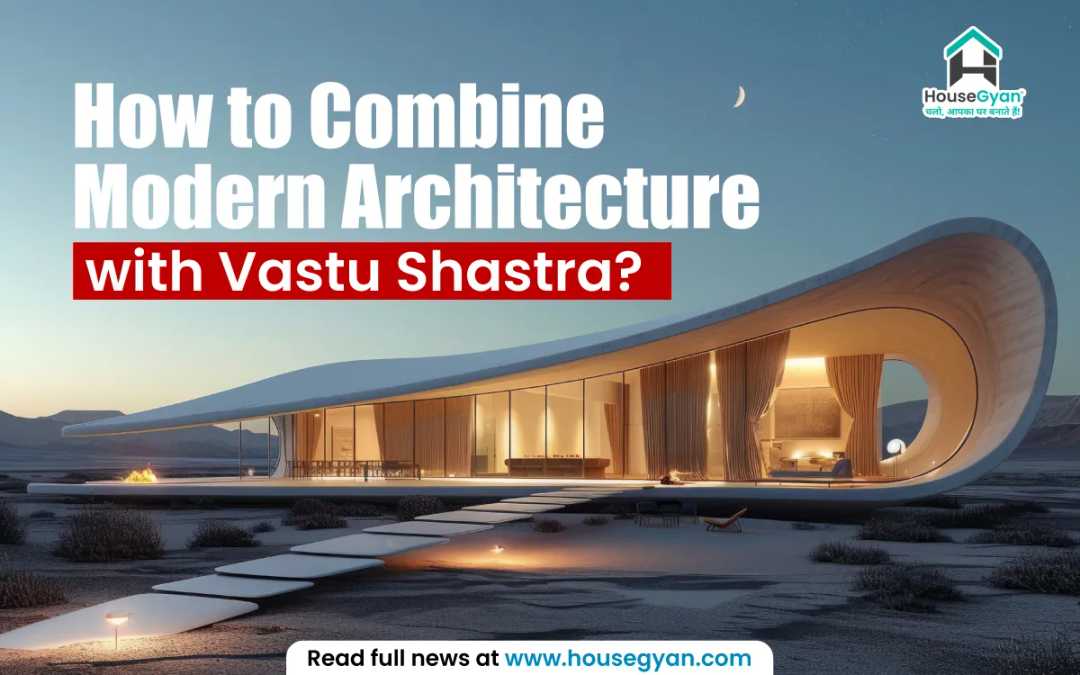
17th, Oct, 2025
How to Combine Modern Architecture with Vastu Shastra?
In today’s world of sleek designs and smart homes, modern architecture focuses on minimalism, technology, and aesthetics. However, ancient Vastu Shastra, India’s traditional architectural science, emphasizes harmony between natural elements, energy flow, and spatial alignment.
When these two are blended thoughtfully, they create homes that are beautiful, functional, and energetically balanced. Let’s explore how to perfectly combine modern architecture with Vastu Shastra in your home design.
1. Understanding the Essence of Both Styles
Modern Architecture emphasizes open layouts, natural light, and sustainable materials.
Vastu Shastra focuses on the five elements (earth, water, fire, air, and space) and directions to ensure health, prosperity, and peace.
Balancing the two means creating a space that not only looks modern but also promotes positive energy flow.
2. Orientation and Direction Planning
Vastu lays great importance on the placement and direction of rooms and entrances.
Here’s how you can align this with modern planning:
Main Door: Should ideally face north, east, or northeast for positive energy flow.
Living Room: Preferably in the north or east direction to receive ample sunlight.
Kitchen: Best located in the southeast (Agni corner) to balance fire energy.
Bedroom: The southwest direction is ideal for stability and sound sleep.
While modern architects may design homes based on sunlight and ventilation, these Vastu directions naturally complement energy-efficient layouts.
3. Use of Natural Light and Ventilation
Both modern design and Vastu encourage maximum natural light and cross ventilation.
You can:
Install large windows in the north and east walls to invite positivity.
Use skylights or glass facades for daylighting while maintaining Vastu balance.
Avoid dark, closed spaces — they hinder energy flow as per Vastu.
4. Integrating the Five Elements (Pancha Bhoota)
Modern architecture can easily integrate Vastu’s five elements:
This creates a balanced home design that feels calm, inviting, and modern.
5. Interior Design and Layout
When blending modern interiors with Vastu:
Choose minimal furniture and avoid clutter to maintain free energy movement.
Use light shades for walls — cream, off-white, or pastel tones work best.
Incorporate wooden elements and indirect lighting for warmth.
Avoid mirrors facing the bed or main door (as per Vastu).
Even with modern modular furniture, maintaining these simple Vastu rules ensures harmony and comfort.
6. Sustainable and Eco-Friendly Approach
Vastu promotes living in sync with nature — and that fits perfectly with modern sustainable design.
Use solar panels, rainwater harvesting, and eco-friendly materials.
Design green terraces and vertical gardens to enhance the Earth element.
Ensure good air circulation with plants like peace lilies or money plants.
This not only fulfills Vastu principles but also aligns with modern eco-conscious living.
7. Exterior and Landscaping Tips
Modern homes with Vastu compliance look stunning when planned holistically:
Keep north and east sides open for better sunlight.
Plant tulsi or bamboo in the northeast for good energy.
Avoid large trees directly in front of the main door.
Design symmetrical façades — Vastu favours balanced geometry.
8. Balancing Technology with Tradition
Modern homes rely on smart gadgets and automation, but energy balance still matters.
Place electronic devices like Wi-Fi routers or TVs in southeast or northwest corners.
Keep sleeping areas free from high electromagnetic exposure.
Use natural décor elements to neutralize artificial energies.
Benefits of Combining Modern Architecture with Vastu
When you bring Vastu Shastra into modern home design, you achieve:
Balanced and peaceful living environment
Improved natural ventilation and light
Positive energy flow in every space
Functional yet aesthetically appealing layout
Long-term prosperity and well-being
Final Thoughts
Combining modern architecture with Vastu Shastra isn’t about giving up contemporary design — it’s about creating a harmonious blend of aesthetics and energy.
By aligning your home’s direction, materials, and layout with Vastu principles, you can enjoy a modern lifestyle that’s peaceful, prosperous, and connected to nature.
If you’re designing your dream home, consider consulting a Vastu expert and an architect together — they can help you achieve the perfect balance of design, comfort, and positive energy.
FAQ
Q1. Can modern architecture follow Vastu Shastra principles?
A1. Yes, modern designs can easily integrate Vastu by aligning rooms, entrances, and materials with directional balance.
Q2. Does Vastu affect home energy and comfort?
A2. Absolutely. Vastu Shastra ensures natural light, airflow, and harmony between the five elements, enhancing well-being.
Q3. Can glass and steel modern homes follow Vastu?
A3. Yes. Even contemporary materials can follow Vastu if orientation, lighting, and element balance are maintained.
Q4. Which direction is best for the main door as per Vastu?
A4. The north, east, or northeast direction is ideal for attracting positive energy and prosperity.











